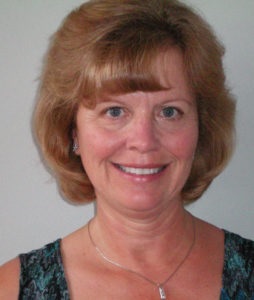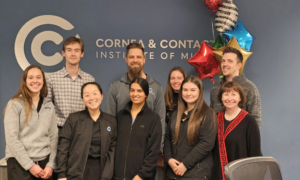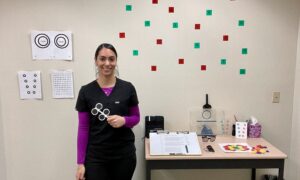By Diane Palombi, OD

Dr. Palombi says the Millennial love of sharing on social media can easily be put to work in marketing your practice.
May 3, 2017
Disparaging Millennials, those born between 1982 and 2002, is so common it has become a joke. There’s a stereotype of the 30-something college graduate steeply in debt, very tech-savvy, and living in their parent’s basement with no intention of moving out. But that really is just a stereotype.
As a Baby Boomer, who was in private practice for 30 years, and is now retired, I believed those stereotypes without thinking for a long time. However, I recently reevaluated my feelings, and have noted the many qualities the youngest employees in the workforce can bring to an optometric practice.
I raised two Millennials, who are responsible adults, and who have taught me a lot. Here are several key ways for even those skeptical of Millennials to make the most of their skills and abilities.
ASK THEM TO MANAGE YOUR SOCIAL MEDIA. Many Baby Boomers, like myself, use Facebook, but we often aren’t as skilled as Millennials at using social media as a platform for event planning and marketing. Before Millennials came into my last practice, the practice wasn’t using social media, and we were missing out on a huge media outlet to reach out to current and future patients, and take advantage of promotional opportunities. Have a conversation at a staff meeting with all employees on the tone you want to set when communicating with patients and the public, and then assign one or two specific employees, whom you trust, to post photos and information about your practice everyday to your practice Facebook and Instagram pages. These tasks can take as little as 20 minutes of the employee’s time per day.
For example, ask the employee to take a photo of new products as they arrive, and then post the photo, along with a few details about the products, to your Facebook and Instagram accounts. Or provide those posting to social media with eye health information and images to post to your social media pages to remind the community that you provide full-scope medical eyecare.
Another idea: Ask each of your opticians to establish style identities that your social media friends and followers can model their own styles after, including coming in to find the glasses that go with those styles. Once a week, have opticians, who are open to doing this, post a photo of themselves in your optical wearing a pair of the frames or sunwear you sell. They can also note in the photo how the eyewear completes the look. Those who follow your social media accounts may begin to recognize the opticians, and their styles, enough to think of your optical shop first when looking for their next pair of glasses.
OPTIMIZE THEIR LOVE OF CHANGE & ADVANCEMENT. Millennials are known as a generation that likes to try new things, and may not have the same patience as older generations for staying for many years in the same position doing the same work year after year. Embrace the adventurous quality that many in this younger generation possess, and give them new challenges once a quarter.
Each year at their performance review, don’t just ask what new skills and experiences they would like to have in your office; map out with them when during the coming year they will get a chance to learn and do all the things you both agree they could try. At the beginning of each quarter, get them trained, or cross-trained, in the skill they say they would like to adopt, and then give them a chance to see how they do with it, and how they like it. Not only will you be building greater flexibility and resilience into your workforce, guarding against service interruptions due to employee illness or vacation, but you will be keeping your employees engaged and excited about their work.
Be sure to recognize the new skills your employees adopt, and even if you can’t afford to give them more money, give them recognition in the form of a new title, a practice-wide announcement, and announcement on your social media, of their accomplishments and new title, and make it clear that you think enough of them to give them greater responsibility.
PROVIDE FLEXIBILITY. Work-life balance is valued by many employees of all ages, but especially younger employees. Rather than having a strict conception of work as happening between 9 a.m. and 5 p.m., younger employees may be more enthusiastic than older generations about flexible scheduling options in which they are responsible for putting in a set number of hours per week, but are able to decide when those hours occur, and for successfully doing the work they are responsible for. If possible, allow your employees flexibility in when they start and finish work, and whether, and how long, their lunch break is, and even the days they choose to work.
You can expand the hours and days of office, or at least, optical shop, operation, by offering flex-time schedules to employees. For example, instead of having all three opticians at your office from 9 a.m. to 5 p.m., Monday through Friday, you could do an analysis of when you have the busiest flow through the office, and then only have all three opticians in at peak times. Instead of cutting their hours (and livelihood), you can spread out the schedules of the three opticians, having each of them choose days when they come in an hour earlier, or stay an hour later, and choosing a day, or hours, that they could substitute for hours, or days, on the weekend. They would be working the same number of hours, but with the chance to choose from a greater number of days and times to fulfill those hours. It’s a win-win, as you offer service at times and days when you previously did not, and you offer employees the chance to take greater control of their work schedules.
THINK BOTTOM-UP; NOT JUST TOP-DOWN. The Baby Boomer generation was known in its youth as a generation that questioned authority, and valued the ideas of everyone, regardless of where they stood in the hierarchy of a company or organization. If you are a Boomer, like me, put that youthful philosophy back into action in how you manage employees. Rather than communicating as the central authority in your practice, communicate as a team member, and cull ideas from the bottom-up.
For example, rather than present to employees your ideas and observations, asking if anyone has questions, and then dismissing a staff meeting, start the meeting by asking each employee to share something good, or bad, that they observed in the office over the last week, along with a suggestion on how to optimize the good thing that happened, so it happens more frequently, or how to make sure the bad thing doesn’t happen again.
You also can make staff meetings, and the office culture, more of a shared endeavor by playing the Game of Business, in which each employee is assigned a practice metric to track, and focus on for improvement.
EMBRACE INNOVATION. Millennials are known for a love of “out of the box” thinking, meaning new takes on how to do old businesses–as in Uber or Lyft instead of a taxi, or Airbnb instead of a conventional hotel stay. Put that spirit of disruption and innovation to work in your office by asking Millennials to tackle long-standing challenges.
For instance, are bottlenecks of patient traffic in your pre-testing area, or optical, happening, yet you can’t afford to expand office space, or hire additional staff? Ask your employees to come up with ideas to meet this challenge, and offer recognition and a reward, like a gift card, or an additional vacation day(s) to the person who comes up with a winning plan. Your youngest, most tech-savvy employees, may have ideas that never occurred to you, like using tablets, or an app, to make the office experience more seamless, and faster, or reorganizing the merchandise selection in the optical to make it easier for modern shoppers to find exactly what they’re looking for faster.
Millennials are different from older generations, but no worse, and even better in many ways. The key is focusing on what you like about them, and what’s useful to your practice, and making the most of it.
How do you optimize the skills and tendencies of your Millennial employees? How do you create a work environment that will engage and retain your youngest employees?
 Diane Palombi, OD, retired now, is the former owner of Palombi Vision Center in Wentzville, Mo. To contact her: dlpod1@hotmail.com
Diane Palombi, OD, retired now, is the former owner of Palombi Vision Center in Wentzville, Mo. To contact her: dlpod1@hotmail.com



























